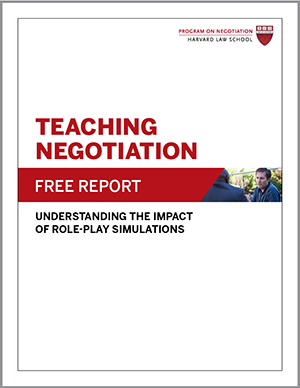
It’s a familiar practice in negotiation role-plays and training:
Students are divided up and assigned to engage in negotiation role-plays known as simulations. Each person reads confidential information about her role, the two (or more) players get together and negotiate, and then the class reconvenes to debrief the experiences.
Negotiation role-plays took root as a common method for teaching negotiation because they allow students to practice their skills in a low-risk setting and requires them to confront common negotiation problems directly, among other benefits.
In the January 2013 issue of Negotiation Journal, George Mason University professor Daniel Druckman and Creighton University Law School professor Noam Ebner discussed the benefits and drawbacks of simulations as a learning tool. Reviewing social science research, they found that engaging in negotiation role-plays improves students’ motivation and retention of key concepts that have already been taught in lectures and classroom discussions. Thus, classes that combine simulations with more traditional classroom methods may maximize learning.
In addition, other learning methods could supplement or expand upon negotiation role-plays, Druckman and Ebner suggest. To take one example, students could be assigned to engage in real-world negotiations and then discuss their experiences back in the classroom.
In a 2012 article for the Negotiation newsletter, professor Alisher Faizullaev, director of the Negotiation Laboratory at the University of World Economy and Diplomacy in Tashkent, Uzbekistan, explains that his students learn broad lessons about negotiation when he assigns them to bargain in the fabled bazaars of Tashkent, Uzbekistan.
“An Eastern bazaar is a perfect place to practice negotiation strategies,” writes Faizullaev. “Here bargaining is not only possible but also essential, and good bargainers are respected by even the most unyielding sellers.”
One assignment Faizullaev gives his students is simply to try to establish a good relationship with the seller and not to bargain for anything at all. “Show an interest in her personality, listen to what she says, try to create an emotional bond, and express yourself sincerely,” he instructs. If a seller offers to sell some of her wares, the student can decide whether to haggle.
The students often leave this exercise feeling pleasantly surprised. Sellers tend to give numerous products to the students for free or for very cheap—all unsolicited.
The strategy is effective, writes Faizullaev, simply because “people value genuine human relationships, and some negotiators, especially in an Eastern bazaar, may be willing to give up certain material goods in exchange for a connection with others. …. [T]he main lesson that students derive from their experience in the bazaar is an appreciation of the importance of establishing meaningful bonds that go beyond business.”
In addition to being assigned to negotiate in the field, students could become involved in the design of negotiation role-plays. In their own classroom experiments, Druckman and Ebner found that negotiation students who were involved in designing a simulation retained concepts better and received more satisfaction from the process than did those who simply role-played the student-designed simulation.
Have you learned anything from negotiation role-plays? Share your experiences in the comments below.
Related Article: The Deal Is Done – Now What?
Adapted from “Make the Most of Your Negotiation Training,” first published in the Negotiation newsletter, November 2013, and “Bargaining Lessons from the Bazaar” by Alisher Faizullaev, first published in the Negotiation newsletter, February 2012.
Originally published in 2013.




